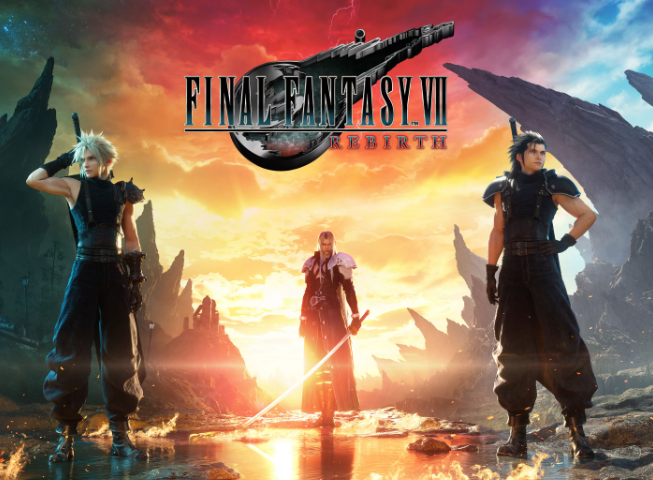
Bryan Jones
Contributing Writer
At a time when the video game industry seems healthier than it has ever been before with legacy titles such as Tekken, Street Fighter and Mortal Kombat, it’s only fitting that another storied video game franchise makes a huge splash within the current industry.
There may be no better way than celebrating a leap year with a leap forward in progress, and that’s exactly what video game publishing and developing company Square Enix did with its latest release; Final Fantasy VII Rebirth.
Longtime fans of the series are in for an immersive experience, with the developers at Square Enix making use of the advanced graphical hardware of the PlayStation 5, this exclusive title is visually stunning, allowing players to explore the semi-open world of Gaia. A sequel to Final Fantasy VII Remake, which was released on April 10, 2020, this world has lush forests, highly detailed grasslands, an appealing steampunk aesthetic and a host of other areas that are available for players to explore within a video game world that feels truly alive.
Conversations between non-playable characters that players meet along their journey are unique, with each bit of scripted dialogue giving the player a whisper of the world’s lore. It’s not uncommon to see events within the wilderness take place either, such as how certain creatures can alter the landscape of combat with their sheer enormity alone. Enemies that were notable in the PlayStation version of Final Fantasy VII are now even more capable of leaving a lasting impression on gamers than ever before.
From the very first moments, players and fans are treated to a touch of exposition, shedding light on the current state of the game’s story as players continue the journey of Cloud Strife and his comrades. Although the game is based off of the original Final Fantasy VII, released on the PlayStation on Jan. 31, 1997, this release quickly sets out to give players a firm message: this is not an exact clone of the original game. That much cannot be understated, as key additions to the game’s world such as map-specific quests are just one of the many new features within the game.
Although it may seem intimidating for those unfamiliar with the franchise, the game does well to welcome new players into the fold. The game places a variety of tutorials throughout the first few hours of gameplay, and these tutorials are kept in a system log menu, should players ever wish to consult them again, and with good reason. While the core gameplay from other games remains, Final Fantasy 7 Rebirth builds upon that wine a fine-tuned combat system that feels less like waiting for a big moment to happen, and more like engagements where every single action taken matters greatly.
While this more action-based style of gameplay is the default setting, Square Enix did place in a Tactical Combat mode that allows players to take a turn-based approach to engagements with enemies, showing a commitment to the role-playing game purist crowd. A slew of other gameplay changes were made, with battles feeling more dynamic, and a lot of the typical hand-holding associated with modern gaming being left on the cutting room floor, thankfully. Players only need so many menus popping up on their screens before it can get overwhelming.
The narrative of Final Fantasy VII Rebirth is paced smoothly, with the first few chapters having a seamless flow that enjoyers of the source material will most likely welcome. Yet, it’s more than just the lore that shines, as characters are given a variety of opportunities to interact, allowing players to view their constantly developing motivations. The choices players make in discussion with other characters leave lasting impressions, so an awareness of their moods needs to be taken into consideration when speaking with them.
Once more, the score is exceptional, with Nobuo Uematsu, returning from Final Fantasy VII Remake to leave a lasting impression that only adds to the immersion of the game’s world. The iconic melodies from the original Final Fantasy VII, which fans have come to know and love, have been remixed, but in a way that modernizes the sound without losing quality, or having to deviate too much from the original. For all first-time players, it’s recommended to take a trip into the battle VR headset, if only to hear Tifa’s battle theme.
While the game is memorable, and stuffed to the brim with things that fans old and new alike will enjoy, it is not without its flaws. There are a few forced stealth sections inserted for the sake of diversifying gameplay, and cutscenes can drag a bit longer than needed with how slow-moving characters can be in them when controlled by the player. Also, Chadley does make a return from Final Fantasy VII Remake, and his presence is even more intrusive than before.
Also, based on the sheer amount of content pumped into this massive semi-open world, newer players may feel a bit overwhelmed by the sheer amount that can be done in-game. Suffice it to say, the game promises to be a lengthy title with a challenging amount of difficulty, often leading to some players needing to repeat battles.
Even in its flaws, the game manages to shine though, as a massive amount of content is not often something that gamers take issue with. What Final Fantasy VII Rebirth does, it does extremely well. It’s more of what fans love, but modernized for the current standard of gaming, creating a visually stunning world with a gripping narrative. Square Enix has crafted yet another exceptional game in their Final Fantasy series. Yet, for all the greatness Square Enix has achieved with the Final Fantasy Series, this one may be the most thrilling yet.

